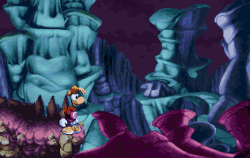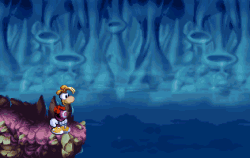| Return to Rayman's Home Page |  Return to Table of Contents |
|
|
The Cave World in the MapperThe Template Map contains the library of all of the blocks available to draw the background for your level. In addition, the five Example Maps contain handy scenery predrawn with the blocks. In the Mapper you can copy any of these blocks to your new level. Template Map:
Example A Map (horizontal map size 600 x 40): |
 |
 |
|
|
Cave Scenery 1 |
Cave Scenery 2 |
The Cave World in the Events Editor |
||
Scenery |
||
 |
Mushrooms: red, yellow or green. They jump up and down. The animated mushrooms also jump from side to side. | |
 |
Butterfly: Butterflies come
in six single colored butterflies (0-blue, 1-red, 2-tan, 3-yellow,
4-gray, 5-green) and multi-colored butterflies which flash all of
the six colors.
Multicolored butterflies:
Single colored butterflies: Single colored butterflies are initially created in color 0 (blue). To change their color, create the butterfly, release the right mouse button, then with the cursor hand still over the butterfly press the UP or DOWN ARROW keys to scroll through the color numbers (0-blue, 1-red, 2-tan, 3-yellow, 4-gray, 5-green).
|
|
Torch: You can place the
torches slightly to the front or back of a rocky path to give a
sense of depth to a scene. Place the background torch towards the
back side of the path and Rayman will appear to walk in front of
it. Place the foreground torch closer to the front of the path and
Rayman appears to walk behind it.
|
||
 |
Birds in love: animated stationary birds. | |
| Electric wire: vertical blocking sprite. It appears solid to Rayman and Rayman can not walk through it. Usually the sprite is connected to a Ting Killdoor that causes the sprite to disappear when Rayman collects all of the colored tings associated with it. (For more information, see the section on Gendoors and Killdoors.) Tip: in the Template Map there is a section of path which you can put where the electric wire will be. When the electric wire disappears, the bottom section of the wires will remain on the path. | ||
| Electric cable: It appears solid to Rayman and Rayman can not jump down through it. It blocks Rayman's progress from top to bottom. Note - Rayman can jump up through it. It does not block Rayman from going up. Usually the sprite is connected to a Ting Killdoor that causes the sprite to disappear when Rayman collects all of the colored tings associated with it. (For more information, see the section on Gendoors and Killdoors.) Tip: in the Template Map there are platforms with wire ends which you can put where the electric cable will be. When the electric cable disappears, the wire ends will remain. | ||
Platforms |
||
 |
Prickly stones: there are
many different varieties of red prickly stone platforms, each with its own
characteristics. For platforms that move, place Reactive
Types in
the Mapper to delineate their area of movement. (For more
information, see the section on Using
Reactive Types.)
|
|
Stalactite platforms: there are
two varieties.
|
||
| Bouncing rock: bounces up
and down. Rayman can safely jump on top of it, but loses a life
point if the bottom of the rock touches him.
Jumping rock: jumps to the right in an arc. Its movement can be controlled by the Reactive Types. (For more information, see the section on Using Reactive Types.) |
||
| Rock: large rock that Rayman can break into pieces by punching it. You can use the rock to temporarily block Rayman's progress, or to hide bonuses. Rayman can also jump on top of the rock and use it as a platform to gain access to upper levels. | ||
Flat stone: there are three
types.
|
||
Enemies |
||
Prickly ball: there are
many different varieties, each with its own
characteristics. For those that move, place Reactive
Types in
the Mapper to delineate their area of movement. (For more
information, see the section on Using
Reactive Types.)
|
||
 |
Big stationary prickly ball | |
 |
Prickly swings: there are two
types.
|
|
|
Large upward peak (beak): stationary until Rayman enters its zone of detection then moves steadily towards the top of the screen.
|
||
Peaks (beaks or stonebirds):
|
||
|
Spider, there are three
varieties:
|
|
| Lightning eyes: throws lightening bolts at Rayman. | ||
Lava rocks:
|
||
 |
Stone men:
|
|
 |
Stone dog: Rayman loses a life point if he touches a stone dog. | |
| This unofficial Rayman site was created by KMG Associates, which specializes in professional game design for web sites. |